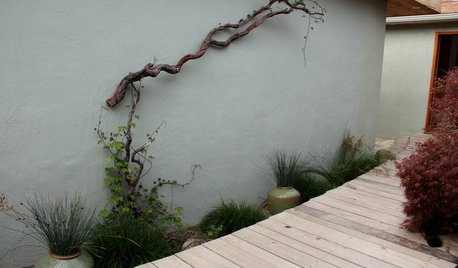Tomato & potato early blight horror: what can I do NEXT year???
Stacey Collins
14 years ago
Related Stories

EDIBLE GARDENSSummer Crops: How to Grow Tomatoes
Plant tomato seedlings in spring for one of the best tastes of summer, fresh from your backyard
Full Story
COOL-SEASON CROPSCool-Season Vegetables: How to Grow Potatoes
This ever-popular tuber is a stalwart in spring and fall gardens and a staple in kitchens everywhere
Full Story
HOUZZ TV FAVORITESHouzz TV: See How Early Settlers Lived in This Restored Pilgrim House
Passionate restoration and preservation efforts give a 1665 home an honored place in the present
Full Story
DECORATING GUIDESStrange but True Parallels Between Early Western and Old Japanese Style
Part 1 of our 'wabi-sabi' series: in which Shaker and Arts and Crafts designs reveal simplicity, modesty and integrity
Full Story
LIFEThe Polite House: How Can I Tell a Construction Crew to Pipe Down?
If workers around your home are doing things that bother you, there’s a diplomatic way to approach them
Full Story
FALL GARDENINGReflecting on a Gardening Year
Mistakes and successes, surprises and comforts. The garden helps us grow in new ways every year
Full Story
STUDIOS AND WORKSHOPSVisit London’s Shed of the Year
A modern Renaissance man carves out a multifunctional green oasis amid London’s urban whirl
Full Story
DECORATING GUIDES13 Ways to Be Happier in Your Home This Year
Savor a richer experience in your house without Herculean efforts or spending a fortune, by focusing on what's important
Full Story
KITCHEN DESIGNThe Cure for Houzz Envy: Kitchen Touches Anyone Can Do
Take your kitchen up a notch even if it will never reach top-of-the-line, with these cheap and easy decorating ideas
Full Story
DECORATING GUIDESSee How Wabi-Sabi Can Bring Harmony and Beauty to Your Home
Create your own wabi-style style with beautifully weathered, humble materials around the house
Full StorySponsored



carolyn137
Stacey CollinsOriginal Author
Related Discussions
potato blight on greenhouse tomatoes
Q
Where to get potatoes, sweet potatoes, onion sets for next year
Q
Early/Late Blight Potato Disease
Q
Do I have a blight resistant tomato?? (pics)
Q
carolyn137
gardener1908
platys
rocky_acres
wordwiz
briergardener_gw
sandy0225
vikingkirken
lisazone6_ma
korney19
rocky_acres
lori_ny
korney19
rocky_acres
korney19
evergreenagriculture
carolyn137
laccanvas
trudi_d
larryw
trudi_d
larryw
trudi_d
Stacey CollinsOriginal Author
larryw
trudi_d
anney
larryw
larryw
anney
tazebell
miesenbacher
anney
nandina
anney
miesenbacher
korney19
miesenbacher
junktruck
moms_helper_2008
superjoezzz
korney19